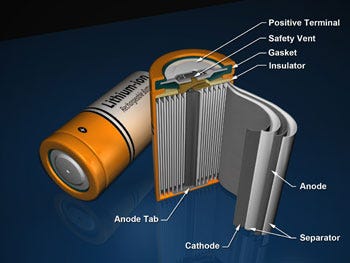Fuel cells, lithium-ion batteries present opportunities for ExxonMobil, BASF, and EDI
ExxonMobil Chemical and EDI have recently announced developments in the separator films used in lithium-ion batteries, and BASF opening a new production center for fuel-cell membranes. ExxonMobil Chemical has launched two new grades of V series co-extruded battery separator films, saying they offer improved thermal stability and lower shutdown temperature for greater safety in hybrid and electric vehicles, power tools, and electronic devices, including laptop computers.
May 12, 2009
ExxonMobil Chemical and EDI have recently announced developments in the separator films used in lithium-ion batteries, and BASF opening a new production center for fuel-cell membranes. ExxonMobil Chemical has launched two new grades of V series co-extruded battery separator films, saying they offer improved thermal stability and lower shutdown temperature for greater safety in hybrid and electric vehicles, power tools, and electronic devices, including laptop computers. Originally launched in 2007, the V-series separator films utilize a proprietary wet bi-orientation manufacturing process.
|
Developmental grade 1 extends thermal stability with an improvement in transverse direction shrinkage to 8% at 130ºC for 30 minutes, from 35.5% in previous-generation films. Developmental grade 2 has improved the shutdown temperature to 128ËšC, compared to 134ËšC for a standard V series grade, while maintaining a longer insulation period with higher meltdown functionality. ExxonMobil currently manufactures battery separator films in Nasu, Japan, and has an additional manufacturing facility under construction in Gumi, Korea, with completion set for 2010.
Extrusion Dies Industries LLC (EDI; Chippewa Falls, WI) now supplies die systems to produce the precise coating and film layers required for the multilayer structures within lithium-ion batteries. EDI has worked on process development with manufacturers of lithium-ion battery components at their facilities and in its film and coating process labs in Chippewa Falls. The company says it has created a system for simultaneously applying anode or cathode coatings to both sides of a substrate, enabling electrode manufacturers to increase productivity by using a flotation dryer to dry both sides at the same time. EDI coating dies apply primer to anode and cathode foil substrates, carbon-based anode slurries onto copper foil, and lithium oxide-based cathode slurries onto aluminum foil. The firm’s cast-film dies are also used to produce micro-porous films that separate the anode and cathode while permitting the passage of ions.
EDI’s work on lithium-ion batteries goes back to 2002 and a U.S. Department of Defense contract for optimizing production of batteries for devices carried by soldiers. The company now supplies its Liberty and Ultracoat slot die coating systems for coating, as well as its Contour dies for separator film extrusion.
German petrochemical giant BASF opened a fuel-cell facility in Somerset, NJ on May 6, with production and automation technologies to fabricate ready-for-use high-temperature Membrane Electrode Assembly (MEA) units. Within a fuel cell, the MEA is where hydrogen and air react with water to generate electrical power and heat. BASF says its MEA contains the world’s first commercially available high-temperature membrane for fuel cells that allows operating temperatures in the range of 320° to 360°F (120°-180°C). The BASF MEA is based on phosphoric acid and polybenzimidazole (PBI), which is a long-chain aromatic polymer with recurring imidazole groups.
Daniel Pepitone, communications manager at BASF told MPW his company’s MEA consists of an ion-conducting membrane sandwiched between two gas-diffusion electrodes. The membrane itself is composed of PBI, which BASF is able to polymerize in the presence of phosphoric acid—a proprietary technology. Pepitone said the PBI itself does not conduct protons or electricity, but once BASF forms the condensation polymer in the presence of concentrated acid, then convert it into a film, it can act as an ion-conducting membrane. Without the phosphoric acid, PBI is typically used in fireproof clothing used by fire fighters, among others.
The company markets the technology as Celtec(R) high-temperature MEAs, saying they are already used in numerous product applications. In addition to operating under high temperatures, BASF says that, as opposed to polymer electrolyte membrane (PEM) fuel cells, the Celtec MEAs are tolerant to impurities in the hydrogen gas, can be air cooled, and don’t have to be hydrated with water, eliminating the need for air humidifiers, water pumps, tanks, valves, and cleaning systems. —[email protected]
About the Author(s)
You May Also Like



